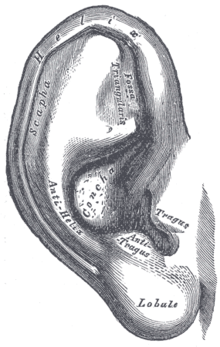耳垂折痕
耳垂折痕(Earlobe crease),又称作法兰克征象(Frank's sign),描述耳垂从耳屏延伸至耳廓后缘的对角线折痕[1][2]。法兰克征象之名以桑德斯·T·法兰克医师之名命名[1]。


目前认为有耳垂折痕者与较高的心血管疾病及糖尿病的发生率相关[3][4][5]。有些研究显示耳垂折痕可以作为心血管疾病的一个指标,但与严重度无关[6]。但也有研究指出耳垂折痕与糖尿病和冠心病并没有关连性[7] [8]。有些研究则着重研究双侧耳垂折痕[9]。
参考文献
编辑- ^ 1.0 1.1 Frank ST. Aural sign of coronary-artery disease. N. Engl. J. Med. August 1973, 289 (6): 327–8. PMID 4718047. doi:10.1056/NEJM197308092890622.
- ^ 2.0 2.1 陈凯力. 驚!耳垂折痕與心血管疾病有關? 醫生:這個年紀更要小心. ETtoday新闻云. 2019-04-19 [2020-08-07] (中文(台湾)).
- ^ Mallinson, Tom; Brooke, David. Frank's Sign as a clinical marker of cardiovascular disease. Journal of Paramedic Practice. 2017, 9 (1): 8-10 [2022-02-08]. doi:10.12968/jpar.2017.9.1.8. (原始内容存档于2021-09-03).
- ^ Miot, H.A., Molina de Medeiros, M. etal (2006). Association between coronary artery disease and the diagonal earlobe an preauricular creases in men. (页面存档备份,存于互联网档案馆) Anais Brasileiros de Dermatologia. vol.81 no.1
- ^ Mustafa Ahmed, M.D. Earlobe Crease And Heart Disease – Fact Or Myth?. Abel Healthcare. 13 August 2014 [8 February 2015]. (原始内容存档于2020-12-03).
- ^ Lesbre JP, Castier B, Tribouilloy C, Labeille B, Isorni C. [Frank's sign and coronary disease]. Ann Cardiol Angeiol (Paris). January 1987, 36 (1): 37–41. PMID 3827155 (法语).
- ^ Davis TM, Balme M, Jackson D, Stuccio G, Bruce DG. The diagonal ear lobe crease (Frank's sign) is not associated with coronary artery disease or retinopathy in type 2 diabetes: the Fremantle Diabetes Study. Aust N Z J Med. October 2000, 30 (5): 573–7. PMID 11108067. doi:10.1111/j.1445-5994.2000.tb00858.x.
- ^ 謠言終結站》耳朵有摺痕恐心肌梗塞?國健署解釋曝光. 自由时报. 2019-07-17 [2020-08-07]. (原始内容存档于2019-07-18) (中文(台湾)).
- ^ Evrengül H, Dursunoğlu D, Kaftan A, et al. Bilateral diagonal earlobe crease and coronary artery disease: a significant association. Dermatology. 2004, 209 (4): 271–5 [2019-08-02]. PMID 15539887. doi:10.1159/000080847. (原始内容存档于2012-03-06).
- ^ George Griffing, M.D. Frank's Sign. The New England Journal of Medicine. March 2014, 370 (15) [2019-08-02]. doi:10.1056/NEJMicm1213868. (原始内容存档于2019-07-21).